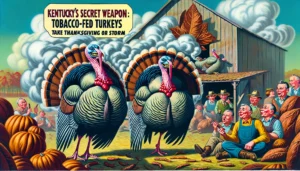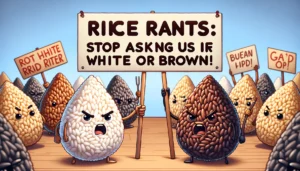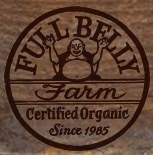
Rodeo Injuries A humorous satirical image in the style of farmercowboy.com showing a cowboy applying lavender essential oil to his injuries after a rodeo. The cowboy4.webp.webp
The Lavender-Laden Bandage: An Essential Oil Revolution
It all started with Clint Johnson, a veteran rodeo rider who’s been thrown, trampled, and dragged more times than he can count. After a particularly rough ride, Clint’s wife suggested that he try lavender oil for his bruises. “I thought she was crazy,” Clint recalled, dabbing the oil on a particularly nasty rope burn. “But then I figured, why not? If it doesn’t work, at least I’ll smell better than I did after rolling in the dirt.”
Clint’s lavender experiment quickly caught on with his fellow cowboys. After all, if Clint—a man whose biceps have biceps—was willing to give it a shot, it had to be worth trying. Soon, rodeo arenas across the country were filled with the scent of essential oils, as cowboys began to explore the aromatic world of alternative medicine.

The Rodeo Aromatherapists Weigh In
Dr. Emily Carter, a sports medicine physician who specializes in rodeo injuries, was initially skeptical about the trend. “I’ve treated broken bones, concussions, and more sprains than I can count,” Dr. Carter said. “But I never expected to see cowboys rubbing lavender oil on a twisted ankle. It’s like they’ve decided to blend rodeo with a day at the spa.”
Despite her reservations, Dr. Carter acknowledges that there may be some psychological benefits to using essential oils. “If it makes them feel better mentally, then I guess it’s not all bad,” she said with a shrug. “Just as long as they don’t start skipping actual medical treatment.”
And therein lies the rub—pun intended. While essential oils may not be a substitute for traditional medical care, they’ve certainly made their mark in the rodeo world, where toughness is worn like a badge of honor. Public opinion is split: Are cowboys becoming too soft, or are they just embracing a new way to heal?
Public Opinion: From Wranglers to Wellness Gurus
A survey conducted at the 2024 Cheyenne Frontier Days revealed that 40% of rodeo participants are open to trying essential oils for minor injuries, while 30% think the whole thing is a joke, and the remaining 30% are just happy to smell better. “I never thought I’d see the day when cowboys were comparing the benefits of lavender versus eucalyptus,” said Sarah Thompson, a barrel racer who’s been in the game for a decade. “But here we are, and I have to admit, my trailer smells amazing now.”
However, not everyone is convinced. Earl Jenkins, a retired rodeo star, is less than enthusiastic about the trend. “Back in my day, we’d just wrap it tight and walk it off,” he grumbled. “These kids today with their oils and lotions—they’re taking all the fun out of rodeo injuries. Next thing you know, they’ll be lighting candles and playing soothing music before a bull ride.”
Anecdotal Evidence: Stories from the Arena
But for every skeptic like Earl, there’s a cowboy like Jason Miller, who swears by his essential oil routine. After getting stepped on by a particularly ornery bronco, Jason decided to forgo the ice pack and reach for his trusty bottle of lavender oil instead. “It didn’t do much for the swelling,” Jason admitted with a chuckle. “But it did help calm me down enough to get back out there. Plus, the other riders didn’t mind standing next to me in the chute for once.”
And then there’s Bethany, a local essential oils distributor who’s found an unexpected market at rodeo events. “I never thought I’d be selling lavender and peppermint to cowboys,” she said with a grin. “But they’re surprisingly open to it. We sold out of eucalyptus by noon!”
Statistical Evidence: Numbers Don’t Lie
The essential oils industry has seen a surprising 15% increase in sales in rural areas over the past year, and vendors at rodeo events are reporting brisk business. “It’s funny,” said Bethany. “You wouldn’t think a guy who wrestles bulls for a living would be interested in frankincense, but here we are.”
Indeed, it seems that the trend is more than just a passing phase. While some cowboys may still be on the fence, the numbers suggest that essential oils are here to stay—at least until the next big thing comes along. And with rodeo riders embracing everything from aromatherapy to herbal supplements, who knows what’s next?
Textual Evidence: The Online Rodeo Wellness Movement
A quick glance at online forums reveals a growing subculture within the rodeo community. One post, titled “Lavender for Lasso Injuries: A Cowboy’s Guide to Essential Oils,” has sparked heated debate. Some posters swear by their oil routines, while others mock the trend as “new-age nonsense.” But despite the jokes, the discussion highlights a shift in the culture of rodeo—a sport known for its ruggedness is beginning to embrace the softer side of healing.
“Back in the day, if you got hurt, you’d just tough it out,” one poster wrote. “Now, it’s all about self-care and wellness. I guess times are changing.”

Analogical Evidence: Comparing Oils to Snake Oil
In a humorous analogy, one cowboy compared essential oils to snake oil: “It might not do anything, but if you think it works, then maybe it does. Plus, at least you won’t smell like the back end of a horse.” The sentiment was echoed by others who, while skeptical, admitted they’d try anything once—especially if it made them smell better than the competition.
Indeed, for some, essential oils offer a form of comfort and control in a sport where injury is a constant risk. “If it helps them feel better, mentally or physically, who am I to judge?” said Nancy, a rodeo medic. “But I’ll still be here with the bandages when they realize lavender won’t fix a concussion.”
Hypothetical Evidence: What If Essential Oils Replaced Traditional Treatments?
Let’s imagine a world where essential oils completely replace traditional rodeo injury treatments. Rodeo arenas would smell like day spas, with diffusers pumping out calming scents between rides. Cowboys would trade their bandages for bottles of eucalyptus, and the rodeo announcer might even remind the crowd to “take a deep breath of frankincense before the next event.”
But in this hypothetical world, there’s a catch—without proper medical care, injuries would pile up. Sure, the cowboys might be relaxed and fragrant, but they’d also be limping, bruised, and probably more than a little dizzy from all the lavender. “You can’t just rub oil on a broken bone and expect to be fine,” warned Dr. Carter. “But if it helps them relax and not overthink the pain, I guess that’s something.”

Insider Perspectives for Farmers & Cowboy Readers:
“How to Wrangle Your Wounds Like a Pro—With Essential Oils!”
- Pro tips: Always carry a bottle of peppermint oil in your saddlebag—it may not cure your sprain, but it’ll keep you smelling fresh.
- Step-by-step guides: How to apply lavender oil to a bruise—because why settle for a bandage when you can smell like a garden?
- Budget-friendly options: If you can’t afford essential oils, just rub a handful of sage from the pasture—it’s basically the same thing.
- Resourceful content: Best practices for blending oils—because mixing lavender and eucalyptus might just give you superpowers (or at least super scents).
- Practical advice: Remember, essential oils are not a substitute for actual medical care—so rub with caution and always seek professional help.
Originally Published at FarmerCowboy.com
2024-08-22 18:43:06
Karl Hoffman is a distinguished agriculturalist with over four decades of experience in sustainable farming practices. He holds a Ph.D. in Agronomy from Cornell University and has made significant contributions as a professor at Iowa State University. Hoffman’s groundbreaking research on integrated pest management and soil health has revolutionized modern agriculture. As a respected farm journalist, his column “Field Notes with Karl Hoffman” and his blog “The Modern Farmer” provide insightful, practical advice to a global audience. Hoffman’s work with the USDA and the United Nations FAO has enhanced food security worldwide. His awards include the USDA’s Distinguished Service Award and the World Food Prize, reflecting his profound impact on agriculture and sustainability.




